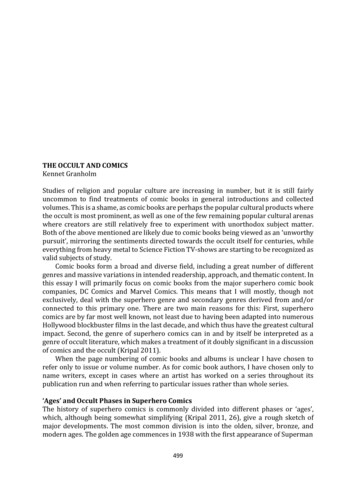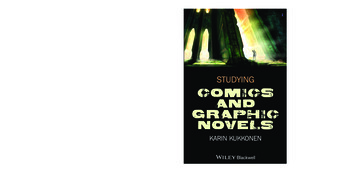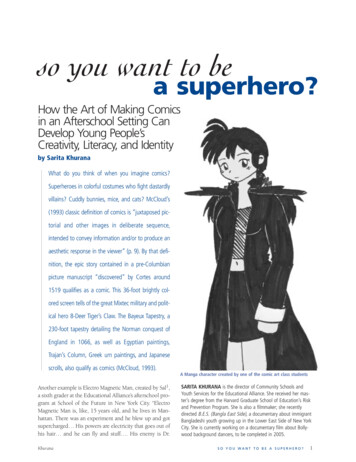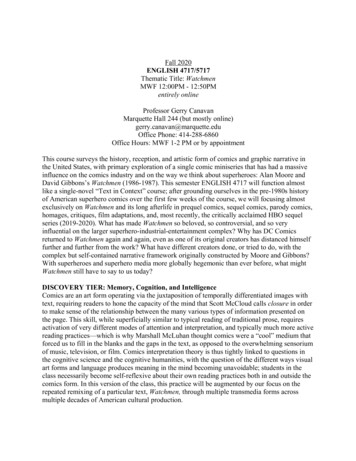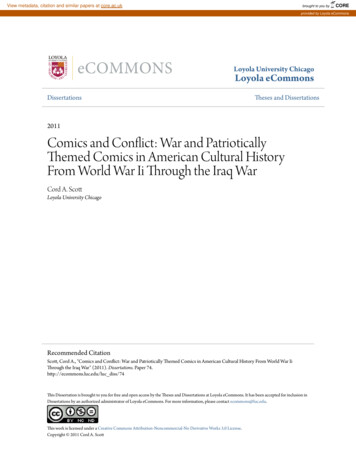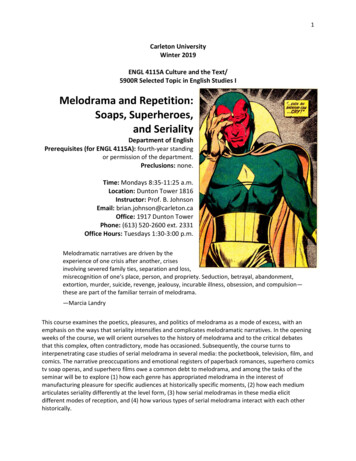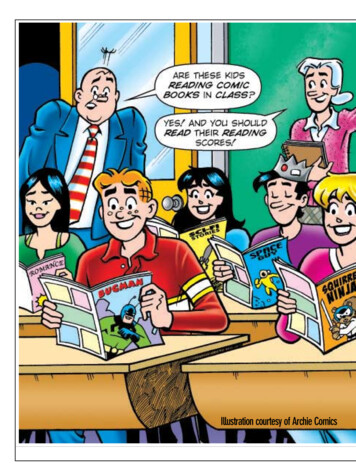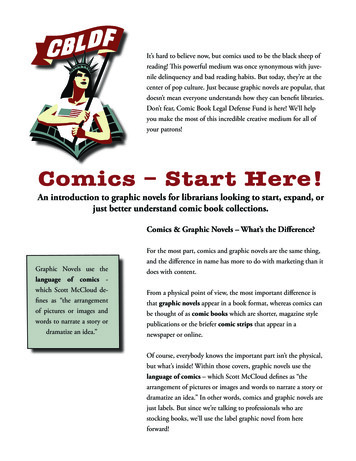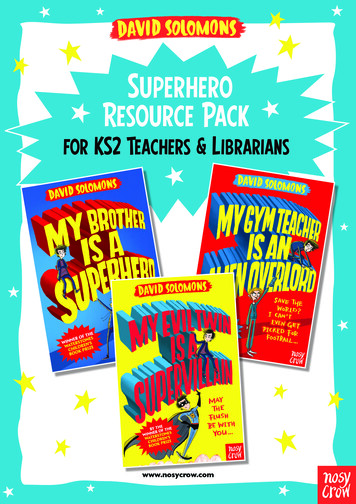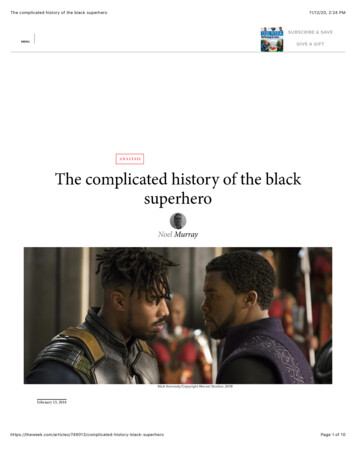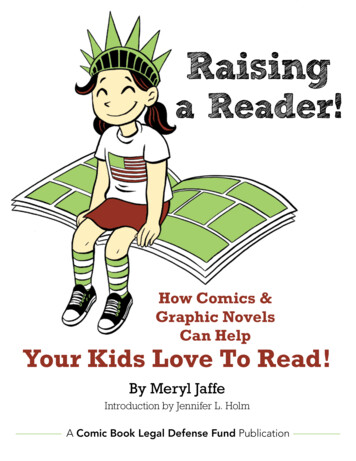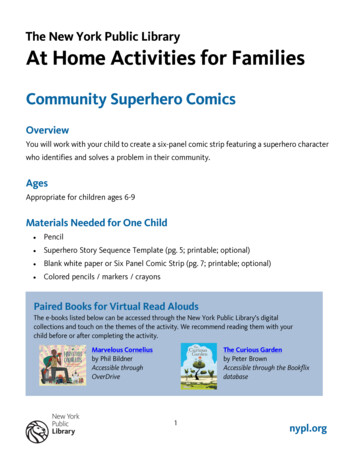
Transcription
The New York Public LibraryAt Home Activities for FamiliesCommunity Superhero ComicsOverviewYou will work with your child to create a six-panel comic strip featuring a superhero characterwho identifies and solves a problem in their community.AgesAppropriate for children ages 6-9Materials Needed for One Child Pencil Superhero Story Sequence Template (pg. 5; printable; optional) Blank white paper or Six Panel Comic Strip (pg. 7; printable; optional) Colored pencils / markers / crayonsPaired Books for Virtual Read AloudsThe e-books listed below can be accessed through the New York Public Library’s digitalcollections and touch on the themes of the activity. We recommend reading them with yourchild before or after completing the activity.Marvelous Corneliusby Phil BildnerAccessible throughOverDriveThe Curious Gardenby Peter BrownAccessible through the Bookflixdatabase1nypl.org
The New York Public LibraryAt Home Activities for FamiliesActivity Instructions1. Ask your child to name a favorite superhero or, if they don’t have a favorite, to name afew superheroes they are familiar with.2. Tell your child that they are going to get to come up with their own unique superherowho solves a problem in their neighborhood and community! They cannot make asuperhero that already exists. They have to make a new superhero. Discuss with yourchild about what makes someone a hero.3. Discuss with your child one or more of the following community heroes for moreinspiration for their superherooNurses and Doctors: they help everyone in the community stay healthyoSanitation Workers: they ensure their community stays clean and beautifuloFirefighters: they fight fires and keep everyone in their community safeoTeachers: they help everyone in their community learn4. Work with your child to identify their: 1) superhero character and name, 2) theirsuperhero’s sidekick or best friend, 3) their superhero’s superpower, and 4) wheretheir superhero lives. If your child struggles with coming up with ideas use thefollowing suggestions:oSuperhero: human; robot; talking animaloSidekick: small animal such as dog, cat, mouse; best friendoSuperpower: flying; super strength; invisibility; reading mindsoPlace where they live: town; city; spaceship; on a mountain2nypl.org
The New York Public LibraryAt Home Activities for Families5. Brainstorm with your child about possible problems that their superhero could solve.Problems should be connected to real or possible community issues. If your childstruggles to come up with their idea, use one of the three ideas listed below.oSomeone stole all the books in the library!oPeople are throwing trash in the river, and it is becoming polluted.oSome kids are being bullies at school.6. After identifying the problem, brainstorm with your child about how their superherowould solve the problem.7. Explain to your child that their story will take place in six parts. Read the SuperheroStory Sequence Example (pg. 4), and then work with your child to write down the sixparts of their story. Make sure there is a clear beginning, middle, and end. Optional:Use the Superhero Story Sequence Template (pg. 5) to write down the six parts ofyour story.8. Show your child the Parts of a Comic Strip (pg. 6) and then work with them totransfer their story onto a comic strip with six panels. You can create your own bydrawing six boxes on a piece of paper or you can print the Six Panel Comic Strip (pg.7). To view comic book examples, visit NYPL’s TumbleBooks database and click on“Graphic Novels.” When drawing and writing in each panel encourage your child to:oDraw what the superhero is doing and add in background and other detail.oWrite out what their superhero is thinking or saying using speech or thoughtbubbles.9. Have your child to share their completed community superhero comic with others!3nypl.org
The New York Public LibraryAt Home Activities for FamiliesSuperhero Story Sequence Example1. Super Maya and her sidekick, Acorn the squirrel, were walkingaround their neighborhood.2. They passed the park and saw that it looked dirty. They walkedcloser to get a better look.3. Maya and Acorn couldn’t believe what they saw! There were emptywater bottles, candy wrappers, and trash everywhere.4. Maya and Acorn started to clean up, but realized they couldn’t doit by themselves.5. Maya used her flying superpower to quickly visit each of herfriends’ houses and ask them to help.6. Maya, Acorn, and her friends cleaned up the park together, andthen made signs that said “Please remember to recycle and throwaway your trash!”4nypl.org
The New York Public LibraryAt Home Activities for FamiliesSuperhero Story Sequence Template1.2.3.4.5.6.5nypl.org
The New York Public LibraryAt Home Activities for FamiliesParts of a Comic StripSpeech Bubbles: Use a speechbubble to capture what acharacter says out loud.Thought Bubbles: Use a thoughtbubble to capture what acharacter is thinking.Sound Bubbles: Add these toyour comic strip to show thesound effects of actions.6nypl.org
The New York Public LibraryAt Home Activities for FamiliesSix Panel Comic Strip7nypl.org
Community Superhero Comics Overview You will work with your child to create a six-panel comic strip featuring a superhero character . Read the Superhero Story Sequence Example (pg. 4), and then work with your child to write down the six parts of their stor
